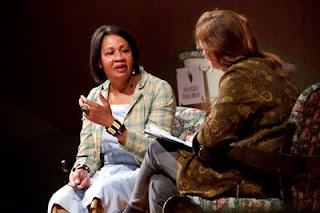Recent Review
How does Jamaica Kincaid's veiled self-reference influence the reading of her new book, "See Now Then"?
All of this is relevant because Kincaid, the author of more than a dozen
books, is a public literary figure. And seen through the lens of some
basic but widely known facts of her life, reading "See Now Then" becomes
quite a different experience.
Even though many of the most recent reviews of Jamaica Kincaid's See Now Then are favorable, readings of her new book are influenced by the autobiographical self-referencing as seen in the above quotation. Hector Tobar describes this reading as disturbing once he realizes the presence of similarity to the author's family,"by the time I reached that last passage, the domestic complications
of See Now Then began to lose their entirely magical and allegorical
qualities and feel more like the nastiness of a real marriage." His sense of the similarity between the author's life and the artistic work, causes him to conduct some research about her personal life. In his reading, knowing that the family composition and marital disagreement are close or shared with the author interrupts his ability to read the work as art (literary prose) alone.
In fact he recommends readers who do not know about her life to avoid the details and warns them to stop reading his review because, "you would enjoy it more." The parallels that he points out between the character Mrs. Sweet and the author Kincaid are that she gardens, lives in small town New England, and the family composition are the same, which taken alone are not so significant. For him, the most impacting similarity is that as the husband and wife trade insults, the physical attributes commented upon are similar to those of the author and her ex-husband's physical appearance. He said the resemblances were disconcerting and he began to feel "voyeuristic." Later, the indications about the father's aggressive feelings toward the son and his possessiveness towards the daughter seem to "express a very personal, private hurt." Tobar concludes that the book deserves to be read as fiction, and yet he clearly cannot avoid making connections. He reads it as a veiled memoir. Certainly, this is a favorable review and yet he concludes:"There are two ways to read Jamaica Kincaid's mesmerizing new novel,
See Now Then.The first is the way any work of art should be read: by simply
absorbing what's on the page. This is how I read the first two-thirds of
See Now Then."
What is important about this review is that even though the reviewer did not know much about Jamaica Kincaid's personal life before reading her novel, he was still influenced by the presence of the autobiographical within her writing.When I heard audio recorded readings of sections of this work, I noted that the audiences laughed at what seemed to be insider jokes; for example, comments that could be about her daughter and son's behavior (but presented in this fiction) has a familiar feeling. For readers who are familiar with the author's previous works, the influence of her autobiography will likely be more forceful.


















